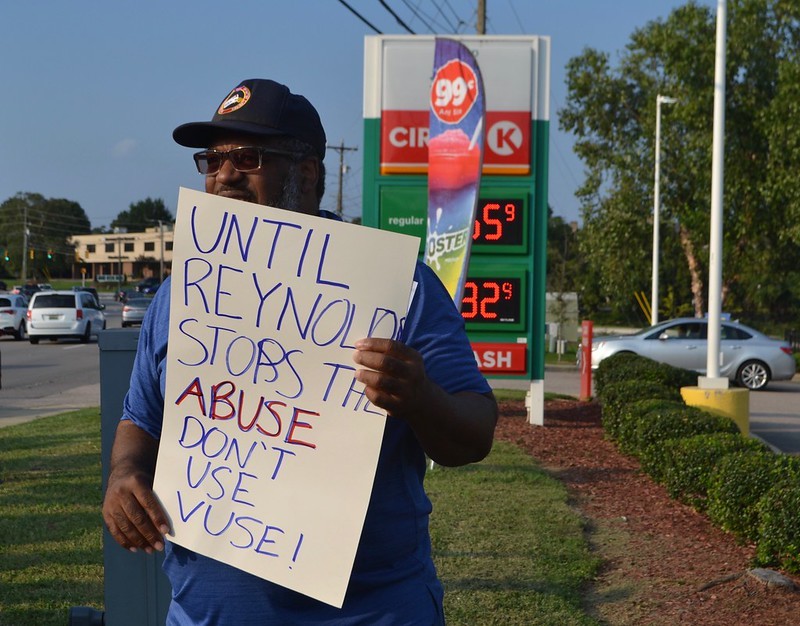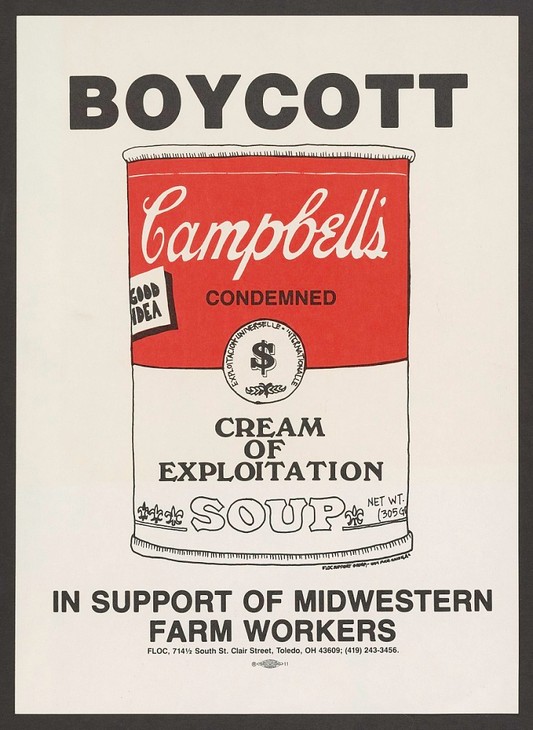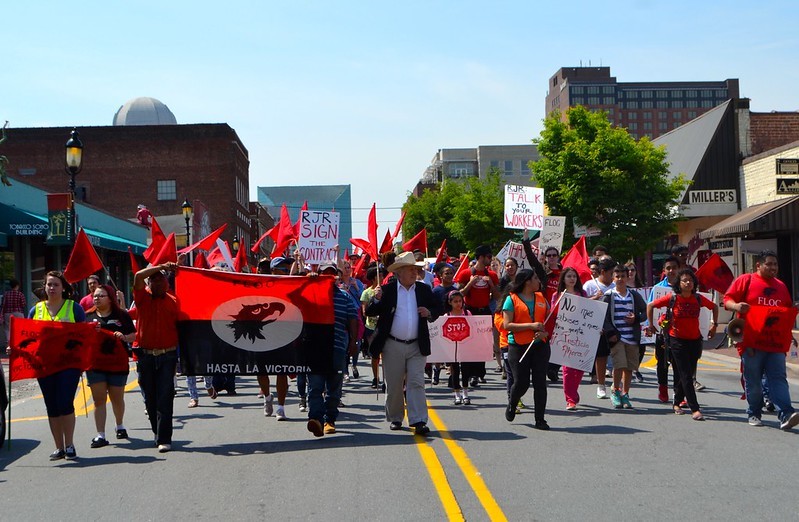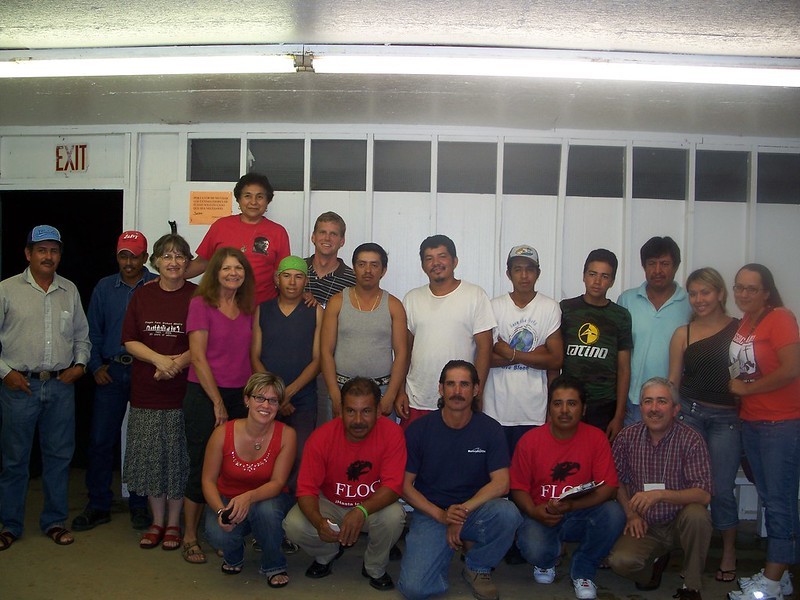Farm Labor Organizing Committee's March on Mt. Olive Pickle Co., NC
Introduction
Text-to-speech Audio
This site is the primary location of Mt Olive Pickle Co. in the town of Mt. Pickle, North Carolina, and marks one of the most influential marches for migrant farmworker rights. Led by Baldemar Velasquez of the Farm Labor Organizing Committee (FLOC), a 70-mile march began from here to Raleigh, NC, from June 23rd through June 26th, 1998. The march protested the working conditions and wages of Mt. Olive Pickles, a pickle-processing company that was preventing workers from unionizing and addressing workplace abuses. FLOC’s history, however, is part of a much broader labor movement for the rights of migrant farm workers, a demographic that is vital to United States food systems, yet chronically under-appreciated and often abused. This site in Mt. Pickle marks the beginning of FLOC’s most successful boycott and was the first instance of a union representing undocumented workers in the United States.
Images
FLOC member holding a sign protesting Vuse in 2018, part of the broader Reynolds American boycott. Reynolds American is one of the largest tobacco manufacturing companies in the world, and is the current target of FLOC.

This poster is one of the original posters used to promote the 1980s boycott of Campbell’s Soup. This boycott was promoted in the mid-1980s and supported by organizations like the Farm Workers Union. Eventually, FLOC was able to negotiate a contract between Campbell’s Soup and the protesting workers.

FLOC and AFL-CIO members march at the Reynolds American 2015 annual shareholders meeting in Winston-Salem, NC. Tobacco companies like Reynolds American are just one example of companies that FLOC and allies visit to protest.

The National Farmworker Ministry holds their 2007 board meeting. The NFWM is a grassroots ally organization of FLOC and was one of the supporters of the march on Mt. Olive. They are also one of the organizations supporting FLOC in the Reynolds America campaign.

Backstory and Context
Text-to-speech Audio
The March on Mt. Olive
The Mt. Olive Pickle Co. march was a 70-mile march led by the president of the Farm Labor Organizing Committee (FLOC), Baldemar Velasquez; it spanned from Mount Olive, NC, to the state capitol in Raleigh, NC, over the course of four days.[1] Assistance with food, housing, and cleaning during the march was provided by the National Farm Worker Ministry, an ally organization focused on labor rights. The purpose of this march was to raise awareness about the working conditions and pay of the farmers who provided cucumbers to Mt. Olive, and to bring Mt. Olive to the negotiating table along with the grower and farmers. However, the march eventually evolved into a full boycott of the company. Prior to this march, FLOC had been having mixed results with boycotts and strikes because their focus was on the growers and not the purchasing corporations, but this boycott sought to bring all three parties to the table. The struggle lasted five years and culminated in 2004, when FLOC coordinated a collective bargaining agreement between Mt. Olive and the cucumber growers, and increased its membership numbers by 35%.[2] This boycott was important to the migrant worker labor rights movement, as it was the first time that a United States union represented undocumented workers, but also for FLOC themselves, as it showed that the new three-way negotiation strategy could be successful.
The Founding of FLOC
FLOC’s founding and current president, Baldemar Velasquez, was born in 1947 as a third-generation Mexican-American immigrant.[3] Although they were all citizens, Velasquez and his family would travel across the county, following crop harvests to work in the fields with other migrant workers. After attending Pan American University and learning about civil rights leaders, Velasquez became inspired by the works of Cesar Chavez and Martin Luther King Jr. and emphasized their use of boycotts and strikes with the founding of FLOC in 1967. Early actions of the organization included partially successful strikes of crop growers and canners, like Campbell's. But after realizing that the growers also faced economic pressure from the purchasing corporations, Velasquez decided that the strikes should be directed primarily at the corporations. This led to the development of the three-way negotiation strategy employed during the Mt. Olive boycott and gave FLOC solid footing to continue their fight for labor rights in the messy agriculture industry of the United States.
Migrant Farm Labor in the United States
The history of migrant farm labor in the United States has been one of constant struggle for labor rights since the 1940s, with FLOC being an influential proponent in the mid-to-late 20th century. The need for increased farm labor in the United States began primarily during the Green Revolution following World War II. It was a period when advancements in agricultural technology (pesticides, fertilizers, GMOs, etc.) allowed for much higher crop yields. Because of these advancements and the loss of workers as a result of WWII, the United States realized a need for increased labor and began to import workers from other countries. One of the first major labor agreements was the Bracero Program with Mexico, which saw the temporary employment of 5 million Mexican workers.[4] The Bracero Program also saw many examples of agency and freedom being stripped from workers, occurrences of wage theft, housing/food violations, and dehumanization, all of which are problems that FLOC continues to fight against.[5] Following the program’s conclusion in 1964, U.S. lawmakers realized the need for consistent labor in the agricultural sector. The United States attempted to permanently address this shortage when, in 1986 under the Reagan administration, the Immigration and Nationality Act was reformed to create the H-2A visa program for agricultural workers.[6] While offering some legal protections, the program was still marred with opportunities for abuse, giving reason for rights advocacy organizations, like FLOC, to be established.
Day-to-day Difficulties
Currently, migrant farmworkers make up almost 3/4 of the labor force in the $134.7 billion-dollar agricultural industry that feeds the nation.[7] The USDA stated that this share is comprised of 4% immigrants who had obtained United States citizenship, 21% authorized immigrants working under labor contracts (H-2A), and the remaining 48% being workers with no authorization.[8] Under the H-2A visa, workers are technically legally protected but also face restrictions to their agency while living and working in the United States. Some of these restrictions include: “Employing H-2A workers will not affect wages and working conditions of similarly employed U.S. workers,” a “maximum period of stay of 3 years,” and restrictions on the specific country of origin.[9] Another H-2A restriction that puts workers in a very precarious position, is the tying of workers to employers. Under current H-2A rule, if a migrant worker is terminated, they are not allowed to find a different employer and remain in the United States. Instead, they are required to return to their country of origin and obtain a contract with a new employer.[10] This leaves the migrant worker vulnerable to workplace abuses, a number which the Department of Labor has quoted as 93,447 from 2000 to 2017.[11] It is also important to note that the small protections included in the H-2A visa are only afforded to those with the visa, and not undocumented workers. In South Carolina, for example, this means that 50% of farm laborers have no protection under the law, a number which has risen from 7% in 1989.[12] Because unauthorized workers are unprotected and authorized workers are often under-protected, it becomes the role of organizations like FLOC to step in and fight for the human rights and collective bargaining rights of said individuals. Housing violations are one example of the benefit that FLOC has provided because companies that form agreements with the union become subject to their inspections. A North Carolina study conducted in 2010 of almost 200 migrant farmworker camps revealed that “violations of housing regulations were common” and ranged from 4 to 22 violations at each camp. This study also found that camps of workers employed by companies that had formed agreements with FLOC were much more adherent to regulations.[13]
Ongoing Efforts
Although FLOC has made significant strides in improving the human rights and collective bargaining rights of migrant farmworkers, the organization has made it apparent that their work is not concluded. The Mt. Olive boycott, for example, was a large step in the right direction for improving the rights of migrant workers because it was the first time that a United States union represented noncitizen migrant workers.[14] However, it concluded only 18 years ago, and current president Baldemar Velasquez has made it clear that work must be continued:
“We can just lay down and let matters overwhelm us and whine and complain about how bad things are, or get up and do something and start speaking to those things that are upon you and those things that are evil.”[15]
As of 2022, FLOC’s current focus is on the company R.J. Reynolds, which is one of the largest tobacco-processing companies in the world, and as FLOC states, “excludes farmworkers from their list of stakeholders.”[16] The current campaign has lasted since 2007 and has included many “dead-end discussions,” showing FLOC and its members' dedication and commitment to fighting for collective bargaining rights.[17] Most recently, FLOC has used the tool of marching during their ongoing campaign against the Reynolds company Vuse.
While these problems may seem daunting, especially for a group with historically very little representation, the work done by FLOC and their affiliates has significantly improved the human and working rights of migrant workers. A history of successful boycotts and eventual three-way agreements between corporations, growers, and farm laborers has shown that, while not simple, improvement is possible even when against massive corporations like Campbell's and Mt. Olive Pickle Co. The work of migrant farm laborers is one of the most understated in the United States, as they put food on the table of millions of Americans, and yet remain discriminated against, exploited, and abused.
Cite This Entry
Daniel Segura and Danille Elise Christensen. "Farm Labor Organizing Committee's March on Mt. Olive Pickle Co., NC." Clio: Your Guide to History. December 6, 2022. Accessed April 3, 2025. https://theclio.com/entry/159659
Sources
[13] Arcury, Thomas. 2012. “Migrant Farmworker Housing Regulation Violations.” American Journal of Industrial Medicine. https://doi.org/10.1002/ajim.22011.
[3] Barger, W. K., & Reza, E. M. (1994). The farm labor movement in the midwest: social change and adaptation among migrant farmworkers (1st ed.). University of Texas Press.
Brook, Chris. 2018. “Federal Court Victory for Migrant Farmworkers Protects Their Right to Organize.” American Civil Liberties Union. September 28. https://www.aclu.org/news/free-speech/federal-court-victory-migrant-farmworkers-protects-their-right-organize.
[8] Castillo, Marcelo. 2022. “Farm Labor.” USDA ERS - Farm Labor. https://www.ers.usda.gov/topics/farm-economy/farm-labor/#:~:text=In%202014%2D16%2C%2027%20percent,percent%20held%20no%20work%20authorization.
Costello, Gerald. "The Farm Labor Movement," U.S. Catholic Historian, Vol. 19, No. 4, 33-40. 2001. https://www.jstor.org/stable/i25154783.
[1] [2] [14] “Farm Labor Organizing Committee.” 2010. Academic Dictionaries and Encyclopedias. https://en-academic.com/dic.nsf/enwiki/1164076.
[5] “A Former Bracero Farmworker Breaks His Silence, Recalling Abuse and Exploitation.” 2022. Los Angeles Times. July 18. https://www.latimes.com/california/story/2022-07-18/former-bracero-farmworker-breaks-silence.
[9] “H-2A Temporary Agricultural Workers.” 2022. USCIS. November 9. https://www.uscis.gov/working-in-the-united-states/temporary-workers/h-2a-temporary-agricultural-workers.
[12] Hill, David P. 2022. “Migrant Labor.” South Carolina Encyclopedia. University of South Carolina, Institute for Southern Studies. August 15. https://www.scencyclopedia.org/sce/entries/migrant-labor/.
Kuhlman, Mary Schuermann. 2022. “Ohio Farm Workers Still Shut out of Federal Labor Protections.” Public News Service. September 13. https://www.publicnewsservice.org/2022-09-13/rural-farming/ohio-farm-workers-still-shut-out-of-federal-labor-protections/a80606-1.
[15] Moyers, Bill. 2013. “Baldemar Velásquez on Fighting for Farmworkers: Moyers & Company.” BillMoyers.com. July 19. https://billmoyers.com/segment/baldemar-velasquez-on-fighting-for-farmworkers/.
[6] Nepal, Sadikshya. 2021. “Primer: Evolution of the H-2A Visa Program.” Bipartisan Policy Center. https://bipartisanpolicy.org/explainer/primer-h2a-visa/.
Quinnell, Kenneth. 2019. “Get to Know AFL-CIO's Affiliates: Farm Labor Organizing Committee: AFL-CIO.” AFL. May 20. https://aflcio.org/2019/5/20/get-know-afl-cios-affiliates-farm-labor-organizing-committee.
[16] [17] “Reynolds Campaign.” 2022. Farm Labor Organizing Committee, AFL-CIO. Accessed November 30. https://floc.com/reynolds-campaign/.
[4] [10] [11] Smolski, Andrew R. 2019. “Stemming the Exploitation of Immigrant Farm Labor.” Contexts 18 (2): 70–71. doi:10.1177/1536504219854727.
[7] Zahniser, Steven. 2022. “What Is Agriculture's Share of the Overall U.S. Economy?” USDA ERS - Chart Detail. February 24. https://www.ers.usda.gov/data-products/chart-gallery/gallery/chart-detail/?chartId=58270.
[Vuse Boycott Sign] By Alexandria Jonas, https://www.flickr.com/photos/nfwm/43014770700/
[Campbell's Boycott Sign] National Museum of American History, https://americanhistory.si.edu/collections/search/object/nmah_531963
[FLOC March] By Alexandria Jonas https://flic.kr/p/sSZgRN
[2007 NFWM Board Meeting] https://flic.kr/p/a7Ccon

